Circular Quay
Circular Quay is a harbour, former working port and now international passenger shipping port, public piazza and tourism precinct, heritage area, and transport node located in Sydney, New South Wales, Australia on the northern edge of the Sydney central business district on Sydney Cove, between Bennelong Point and The Rocks. It is part of the local government area of the City of Sydney.[1]
| Sydney Cove | |
.jpg) Circular Quay from the Sydney Harbour Bridge | |
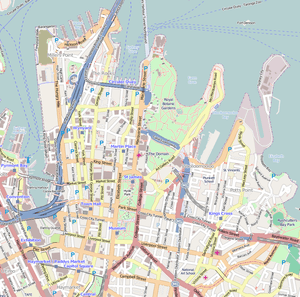 | |
| Part of | Port Jackson |
|---|---|
| Type | |
| Owner | Property NSW |
| Location | Sydney central business district, City of Sydney, New South Wales, Australia |
| Coordinates | 33°51′40″S 151°12′40″E |
| Construction | |
| Construction start | 1837 |
| Completion | 1844 |
| Other | |
| Known for | Sydney New Year's Eve |
The Circular Quay area is a popular neighbourhood for tourism and consists of walkways, pedestrian malls, parks and restaurants. It hosts a number of ferry quays, bus stops, and a railway station.[2] Often referred to as the "gateway to Sydney", the precinct has views of the Sydney Harbour Bridge and the Sydney Opera House and is a common location for viewing Sydney New Year's Eve fireworks.
History
Indigenous history
The native name for Circular Quay was Warrung meaning 'Little Child.[3]
Also used to be called semi circular quay.
The first people to occupy the area now known as Sydney were Australian Aborigines. Radiocarbon dating suggests that they lived in and around Sydney for at least 30,000 years.[4] In an archaeological dig in Parramatta, Western Sydney, it was found that the Aboriginals used charcoal, stone tools and possible ancient campfires.[5] Near Penrith, a far western suburb of Sydney, numerous Aboriginal stone tools were found in Cranebrook Terraces gravel sediments having dates of 45,000 to 50,000 years BP. This would mean that there was human settlement in Sydney earlier than thought.[6]
Prior to the arrival of the British there were 4,000 to 8,000 native people in the Sydney area from as many as 29 different clans.[7] Sydney Cove from Port Jackson to Petersham was inhabited by the Cadigal clan.[7] The principal language groups were Darug, Guringai, and Dharawal. The earliest Europeans to visit the area noted that the indigenous people were conducting activities such as camping and fishing, using trees for bark and food, collecting shells, and cooking fish.[8] The "Eora people" are the coastal Aborigines of the Sydney district. The name Eora simply means "here" or "from this place", and was used by Local Aboriginal people to describe to the British where they came from. The Cadigal band are the traditional owners of the Sydney CBD area, and their territory south of Port Jackson stretches from South Head to Petersham.
Colonial settlement
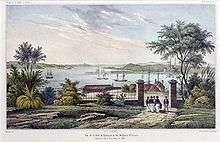
Sydney Cove, on which Circular Quay is located, was the site of the initial landing of the First Fleet in Port Jackson on 26 January 1788.
The governor's temporary canvas house was erected on the east side of the cove,[9] while the western shore became the centre of the early settlement. It was the focal point from which the city of Sydney grew. The first wharf on the shore of Sydney Cove probably dated from around 1792. In 1802 it was replaced with a timber framed wharf called "Hospital Wharf", the first public wharf of the colony (later renamed King's Wharf and Queen's Wharf).
Late 18th-century Scottish constitutional reformer Thomas Muir was sentenced to transportation to Sydney for sedition, and had a cottage on what is now Circular Quay. Thomas Muir escaped from the colony in 1796 aboard an American brig, the Otter.
The eastern side of the cove remained largely uninhabited in the early years of the colony; one notable inhabitant was Bennelong, after whom the adjacent Bennelong Point and Bennelong Apartments are named. In the early 19th century, the entire eastern shore of Circular Quay was part of the Governor's Domain, though some commercial activity developed along the shoreline. The western shore, being adjacent to the original settlement now known as The Rocks, was busier. Cadman's Cottage is a building which survives from that era, built in 1816 for the use of the governmental coxswains and their crews, it marks approximately the location of Circular Quay's natural western shore, prior to reconstruction. The Commissariat Stores (built in 1809) and Australia's first naval dock were also located on the western shore. The naval dockyard was expanded in 1818-1822 under Governor Macquarie, with four repairing docks.
Working port
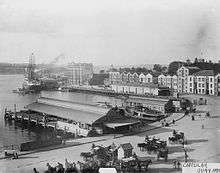
Circular Quay was constructed in 1837-1844 by reconstructing the southern section of Sydney Cove with an artificial shoreline. The mouth of the Tank Stream, which flowed into Sydney Cove at the western end of Circular Quay, was in-filled. The harbour was originally known as "Semi-Circular Quay", this being the actual shape of the quay. The name was shortened for convenience.[10] Wharves were built on the southern shore. Reflecting Circular Quay's status as the central harbour for Sydney, the Customs House was built on the southern shore in 1844-5. During the construction of Circular Quay, the eastern side of the cove was used as a quarry and housed construction works. After the governor's residence was moved up the hill to the present Government House in the 1840s and 1850s, Macquarie Street was extended north through the Governor's Domain to Fort Macquarie. This led to the development of the area between the street and the shore into a commercial working wharf dominated by the wool trade, while the eastern side of the street remained part of the Domain. This part of Macquarie Street became known as the "wool store" end.[9] Wool and bond stores and warehouses appeared on the site. The historic "Moore Steps" was built in 1868 as a passage between two wool stores, leading from the shore to Macquarie Street. By the 1860s, all three sides of Circular Quay were dominated by wharves and warehouses.
However, by the 1870s, much of the commercial shipping activities was moving away from Circular Quay. The harbour was becoming too small to accommodate the increasing number of large ships accessing Sydney. Instead, shipping activities moved further westwards to Darling Harbour, which also had the advantage of a railway line.
With the absence of commercial shipping, the harbour became increasingly used for passenger transport. The first ferry wharf was built on the southern shore in 1879. From the 1890s, ferry terminals came to dominate the harbour, and Circular Quay became the hub of the Sydney ferry network. The Sydney Harbour Trust was formed in 1900.
Transport developments
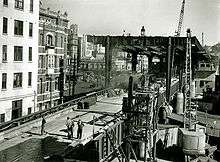
Circular Quay was also a tram hub. It was the focal terminal point of most electric tram services to the Eastern Suburbs. The first tram to operate through Circular Quay was horse-drawn, running from the old Sydney Railway station to Circular Quay along Pitt Street in 1861[11] allowing easy transfer to ferries. Trams operated from Central station down Castlereagh Street to Circular Quay and back up Pitt Street in a large anti-clockwise loop. For many years, 27 regular services operated from Circular Quay.[12][13]
From 1936, the appearance of Circular Quay was dramatically changed with the construction of a railway viaduct, and later the elevated Cahill Expressway above the viaduct, across the southern shore of the cove. The Circular Quay railway station was opened on 20 January 1956[14] and the elevated Cahill Expressway was officially opened on 24 March 1958.[15]
Building developments
.jpg)
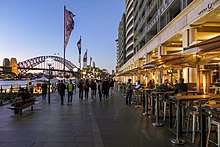
The construction of the viaduct led to the demolition of the old Maritime Services Board building on the south-western shore. A replacement was constructed further north in 1940, and is today the Museum of Contemporary Art. Further north, the Sydney Cove Passenger Terminal was built in 1958-1960 to accommodate the increasing number of passengers arriving by ship. The building was renovated in 1988, 2000 and 2014. Large liners and cruise ships often dock here, their size dominating the cove. East Circular Quay was redeveloped from the 1950s with the replacement of wool stores with modernist commercial buildings. The Sydney height limit was increased from 46 to 279 metres (150 to 915 ft) in 1959, and a number of Sydney's first skyscrapers were built around Circular Quay. The AMP Building on the southern shore was Sydney's tallest building when completed in 1962. In 1973 the Sydney Opera House was completed at the northeastern end of Sydney Cove.
Between 1971 and 1989, Colonial Mutual Life acquired land along Circular Quay for a large scale development. The initial design caused significant controversy around the country, including intervention by the Prime Minister, Paul Keating, and internationally.[16] A revised 1992 design had the developer reducing building height and providing a colonnade for public access, in exchange for the development extending further towards the foreshore. The resulting development of Bennelong Apartments (nicknamed by critics as The Toaster), and is criticized for it positioning and for obscuring views of the Sydney Opera House, from the main pedestrian approach.
In 2019, several property developments underway by the private sector in the area, including: Quay Quarter Sydney by AMP Capital, Opera Residences, One Circular Quay by Yuhu Group, Circular Quay Tower by Lendlease, and the Sandstone Hotels precinct by Pontiac Group. In addition, the Sydney Opera House is undergoing its largest renewal project since its opening.
Transport
| 🌍 |
by Transport for New South Wales. |
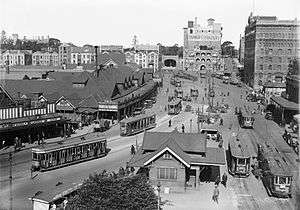
Circular Quay is a major Sydney transport hub, with a large ferry, rail and bus interchange. The Cahill Expressway is a prominent feature of the quay, running from the east, over the elevated railway station to join the Sydney Harbour Bridge in the west. International ships have docked and moored at Circular Quay since the earliest years of the colony. The Overseas Passenger Terminal, situated on the Quay, is a major piece of Sydney transport infrastructure serving cruise ships and ocean liners and their passengers.
The railway station is the only station on the City Circle that is above ground. The platform looks out over the ferry terminus, providing views of Sydney Harbour, including the bridge and Opera House.
The wharf complex hosts five commuter ferry wharves and is the terminus for all public ferry routes in Sydney Harbour and the Parramatta River other than the Mortlake Ferry between Mortlake and Putney.
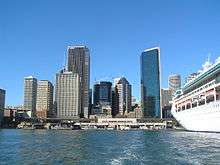
Circular Quay was formerly a large tram terminus and interchange. As many Sydney bus routes follow the previous tram lines, the tram terminus in Alfred Street became a major bus terminus for many bus routes.[17] A redesign of CBD bus services in October 2015 reduced the number of bus routes serving the Quay.
In response to increasing bus congestion in the CBD, on 13 December 2012 the NSW Government announced a commitment to build a $1.6 billion light rail from Circular Quay down George Street to Central Station, then across to Moore Park and down Anzac Parade. South of Moore Park the line would split into two branches - one continuing down Anzac Parade to The Nine Ways at Kingsford, and the other heading to Randwick via Alison Road.[18] Construction commenced in October 2015. This light rail system which became fully operational in April 2020, has a station located on the corner of Loftus Street, Circular Quay.
Culture
Circular Quay is a focal point for community celebrations, due to its central Sydney location between the Sydney Opera House and the Sydney Harbour Bridge. It is one of the main congregation points for Sydney New Year's Eve.
Circular Quay is also the home of Sydney's Museum of Contemporary Art and the City of Sydney Library in the heritage-listed Customs House. Sydney Writers Walk - a series of plaques commemorating writers with some connection to Sydney - was installed in the footpath along Circular Quay in 1991. In autumn 2006, the largest open-air art exhibition ever in Australia took place on Circular Quay: Over 7 weeks the Berlin Buddy Bears visited Sydney.[19] Each bear represented a member-country of the United Nations, symbolizing the universal principles of peace, freedom and friendship.[20]
The Quay is mentioned in the classic song "And the Band Played Waltzing Matilda" (1971) by Eric Bogle. "Circular Quay" is the title of a song from Dr. Robert of The Blow Monkeys which appeared on his 1994 debut solo album, "Realms Of Gold". The song was also issued as a single in the same year.
Water Polo by the Sea is held there every year by Australian Water Polo with the Australia men's national water polo team take on the International All Stars.[21]
See also
References
- "Circular Quay". Geographical Names Register (GNR) of NSW. Geographical Names Board of New South Wales.

- "Circular Quay". Sydney.com. Retrieved 5 April 2013.
- Andrews, Graeme (1982). A Pictorial History of Ferries: Sydney and Surrounding Waterways. Sydney: AH & AW Reed Pty Ltd. p. 9. ISBN 0589503863.
- Macey, Richard (2007). "Settlers' history rewritten: go back 30,000 years". The Sydney Morning Herald. Retrieved 5 July 2014.
- Blainey, Geoffrey (2004). A Very Short History of the World. Penguin Books. ISBN 978-0-14-300559-9.
- Stockton, Eugene D.; Nanson, Gerald C. (April 2004). "Cranebrook Terrace Revisited". Archaeology in Oceania. 39 (1): 59–60. JSTOR 40387277.
- "Aboriginal people and place". Sydney Barani. 2013. Retrieved 5 July 2014.
- "Cook's landing site". Department of the Environment. 2014. Retrieved 5 July 2014.
- "East Circular Quay". Dictionary of Sydney.
- "Sydney town and port established 1788 – 1900" (PDF). Sydney Ports Corporation. 21 August 2006. Archived from the original (PDF) on 21 August 2006.
- Wylie, R. F. (February 1965). "The 1861 Pitt Street Tramway and the Contemporary Horse Drawn Railway Proposals". Australian Railway Historical Society Bulletin: 21–32.
- Wylie, R. F. (July 1974). "The Cable Trams of Sydney and the Experiments Leading to Final Electrification of the Tramways". Australian Railway Historical Society Bulletin: 145–168, 190–192.
- Wylie, R. F. (March 1969). "The Inauguration of Sydney's Steam Tramways". Australian Railway Historical Society Bulletin: 49–59.
- Circular Quay Railway Station and Viaduct NSW Environment & Heritage Retrieved 4 December 2014
- "How to Build a Street Cahill Expressway". City of Sydney. Archived from the original on 15 June 2016.
- "Tempest Swirls around Sydney's Landmark Opera House". Christian Science Monitor. 17 July 1998. p. 3.
- "Sydney's tram history". railpage.org.au. Archived from the original on 13 November 2012.
- "Sydney's Light Rail Future". Transport for New South Wales. 13 December 2012. pp. 15, 24. Archived from the original on 19 January 2013. Retrieved 14 December 2012.
- United Buddy Bears in Sydney 2006
- Messages of Greeting by John Howard
- Water Polo by the Sea website
External links
| Wikimedia Commons has media related to Circular Quay, New South Wales. |
- ABC's Sydney Sidetracks explores the history of Circular Quay
- Paul Ashton (2008). "East Circular Quay". Dictionary of Sydney. Retrieved 27 September 2015. [CC-By-SA]
- Peter Bolt (2008). "King's Dockyard". Dictionary of Sydney. Retrieved 8 October 2015. [CC-By-SA]
- "Commissariat Stores". Dictionary of Sydney. Dictionary of Sydney Trust. 2008. Retrieved 13 October 2015. [CC-By-SA].